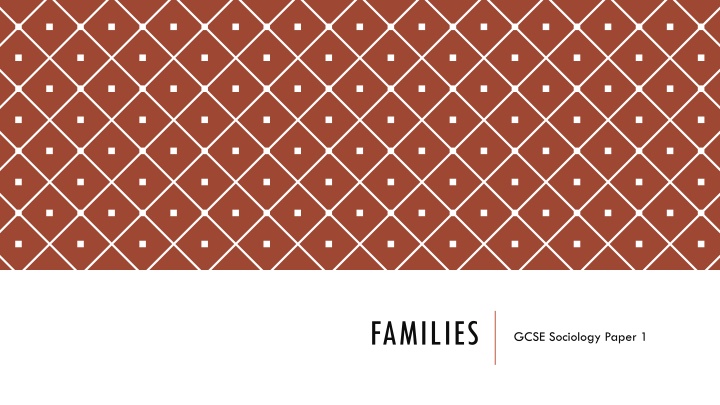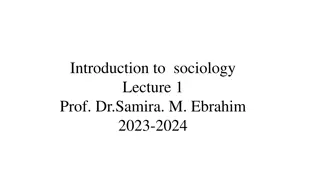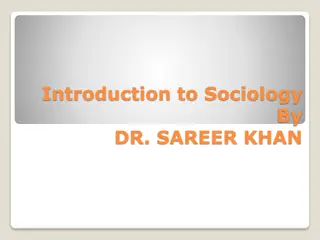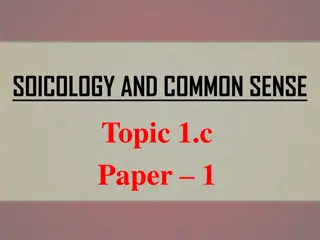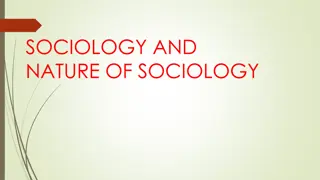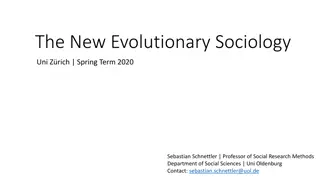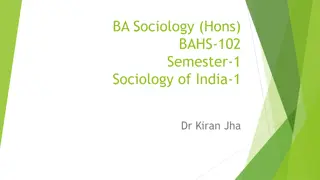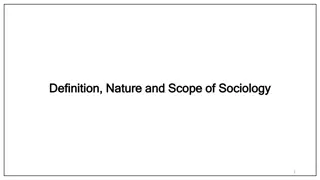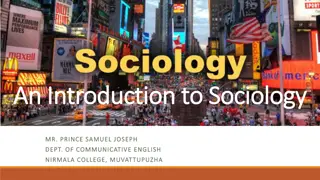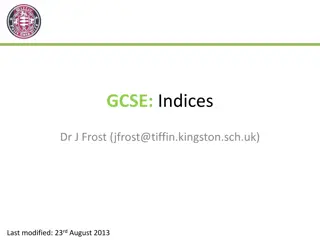Comprehensive GCSE Sociology Families Study Guide
Explore GCSE Sociology Families topic through a PowerPoint presentation with detailed information on family forms, types of family/household, key term definitions, and various tasks for students to complete. The guide encourages students to work steadily through the topics, make detailed notes, and choose challenging tasks for better understanding. Additional resources such as key term glossary, revision booklet, and exam papers are provided to aid in studying. Students are advised to seek help from sociology teachers if needed.
Download Presentation

Please find below an Image/Link to download the presentation.
The content on the website is provided AS IS for your information and personal use only. It may not be sold, licensed, or shared on other websites without obtaining consent from the author.If you encounter any issues during the download, it is possible that the publisher has removed the file from their server.
You are allowed to download the files provided on this website for personal or commercial use, subject to the condition that they are used lawfully. All files are the property of their respective owners.
The content on the website is provided AS IS for your information and personal use only. It may not be sold, licensed, or shared on other websites without obtaining consent from the author.
E N D
Presentation Transcript
FAMILIES GCSE Sociology Paper 1
INSTRUCTIONS Please work through the information on this PowerPoint at a steady pace- try to cover 3-4 topics each week. There are 17 topics in total; some are shorter than others so won t take as much time. You will need to make detailed notes, in your own words. After each topic, you have a choice of tasks to complete. Make sure you pick one with an appropriate level of challenge, i.e. don t always pick the easy option that will be finished quickly. Try to answer at least two essay questions over the course of the topic. If you are stuck, don t understand something, or would like your work to be marked, please email your sociology teacher. We will be more than happy to help you! Miss Chester- schester@hamptoncollege.org.uk Mrs Reinis-Keightley- NReinis-Keightley@hamptoncollege.org.uk Miss Williams- hwilliams@hamptoncollege.org.uk
INSTRUCTIONS Also uploaded onto the school website were a key terms glossary, and a revision booklet. Try to complete these as revision when you have finished the topic. If you wanted to try an exam paper, you can look on this website for a paper 1 to try (paper 1- education, families, methods)- https://www.aqa.org.uk/subjects/sociology/gcse/sociology-8192/assessment- resources Please make sure you are working through the topics as best you can. We will not have time next year to recap everything in detail, so you really need to try and understand/revise the information as much as possible, otherwise you will struggle next year!
FAMILY FORMS Topic 1
TYPES OF FAMILY/HOUSEHOLD Key Term Definition Family A group of two or more people linked by birth, marriage, adoption or cohabitation based on a long-term relationship Household A group of people living together in the same dwelling Cohabiting Partners who live together without getting married Nuclear Family A family group consisting of parents and their children Extended Family Parents, their children, and other more distant relatives Reconstituted Family When two adults with children from previous relationships remarry (or cohabit) to form a new family. Also called a blended family. Lone Parent Family A family with only a mother or father as a consequence of death, divorce, or individual choice Same Sex Family Family headed by a couple of the same sex Beanpole Family A family whose living members come from many generations, but with few members in each generation Empty Nest Family A stage in the life cycle of a family when children have reached adulthood and moved out of the parental home Family Diversity The many different types of family structure that exist in contemporary society
TASKS When you have finished making your notes, choose at least one of the following tasks to complete: Create flashcards for each key term Create a mind map which includes each key term Draw a picture (stick men are fine!) to represent each key term
FUNCTIONALIST PERSPECTIVE OF THE Topic 2 FAMILY
FUNCTIONALIST VIEWS ON FAMILY Functionalists are interested in the positive functions of a family. They view the family as the cornerstone of society, as it prepares individuals to join the rest of society through primary socialisation. Functionalists think that the nuclear family is beneficial to all of its members, and is necessary for society to run smoothly.
MURDOCK Murdock argued that all families fill four vital functions: 1. Sexual: marital sex encourages fidelity and commits the individual to family life. This encourages stable relationships, which help maintain a stable society. 2. Reproductive: society needs new members in order for it to continue. This generally occurs within marital and family contexts. 3. Educational: primary socialisation to teach children the culture of society, so that they are prepared to join it. 4. Economic: providing shelter, food, and money. When families buy things to meet the needs of their children, this also helps the economy.
PARSONS Parsons believed the family serves two important functions that cannot be performed by other institutions: 1. Primary socialisation: passing on the norms and values of society. Teaching children the rules and belief systems. Parsons saw mothers playing the key role in this, arguing that men and women are biologically suited to different roles. Men play an instrumental role- working and earning money, and women play an expressive role- looking after the children. 2. Stabilisation of adult personality: also known as warm bath theory. The family provides support in a warm and loving home in which adults can be themselves and relax, from the pressures of society and the workplace.
CRITICISMS Functionalists ignore conflict in family, and the dark side of the family , e.g. violence and abuse Cheal (2002) argued that functional relationships can become dysfunctional, and functionalists ignore this Functionalist views on the family are based on research conducted with American middle-class family life, and have not considered anyone different. The research may be outdated- particularly Parson s views on instrumental and expressive roles.
TASKS When you have finished making your notes, choose at least one of the following tasks to complete: Create a poster to display the information on functionalist views of the family Create flashcards for Murdock and Parsons- these are key sociologists for this topic! Write a detailed paragraph explaining whether you agree with the functionalist perspective on families & why
MARXIST PERSPECTIVE OF THE Topic 3 FAMILY
Key Sociologist Zaretsky summarises these ideas by saying: The family is a prop to the capitalist system whilst also serving as a vital unit of consumption. MARXIST THEORY Marxists look at how the family contributes to the maintenance of society s structure. Marxists argue that the nuclear family performs several important functions for capitalism: Families are seen as consumer units as they buy products from a variety of markets. This allows the bourgeoisie to make a profit, and therefore supports capitalism. Private property is an important asset to the nuclear family, and by passing it on, families can build up wealth over generations. The process of primary socialisation in the family reproduces and maintains class inequalities. Marxists claim that the family is one way to maintain and reinforce a set of ideas, which in turn maintain capitalist society. Families also support capitalism by providing unpaid labour by reproducing, caring for and socialising the next generation of workers, and providing emotional support for workers to help them deal with the exploitation they experience in work.
CRITICISMS OF MARXISM The idea that families exist to pass on ruling class ideas ignores the other things that go on in families. People today are more likely to marry for love and affection rather than as a social obligation. Marxism could be seen as over-negative; playing down the benefits that families hold for their individual members, such as the emotional aspects of relationships and personal fulfilment for both parents and children.
TASKS When you have finished making your notes, choose at least one of the following tasks to complete: Create a poster to display the information on Marxist views of the family Create a flashcard for Zaretsky s ideas (include more detail than what is in the box- use information from the rest of the slide too!) as he is a key sociologist for this topic! Write a detailed paragraph explaining whether you agree with the Marxist perspective on families & why
FEMINIST PERSPECTIVE OF THE Topic 4 FAMILY
FEMINIST VIEWS IN GENERAL Marxist feminist: explore how women are oppressed by men and capitalism. They support their husbands so that they can contribute to the economy, and raise the next generation of workers- all for no pay! Liberal feminist: argue that change has taken place through legislation, e.g. the 1970 Equal Pay act and 1975 Sex Discrimination Act. Believe that improvements will continue by means of legislation and policy. Radical feminist: men dominate and oppress women. The socialisation of women as housewives and mothers oppresses them.
FEMINIST VIEWS ON FAMILY Marxist Feminist Men benefit more from family life than women. A woman s role is to support the husband in a capitalist society, and produce the next generation of workers- at no cost to the capitalist class. This also benefits men as women cannot compete for promotions as they do not have the same experience, if they have taken time out. Radical Feminist The nuclear family benefits men the most, because gender role socialisation results in boys and girls behaving in stereotypical ways, for example, the sexual division of labour. Liberal Feminist There is increasing equality between men and women- men have more paternity leave, and women can no longer be discriminated against due to having children. Evaluation: assumes that all heterosexual couples involve exploitation of women. Portrays women as passively accepting their role, but this is not the case.
TASKS When you have finished making your notes, choose at least one of the following tasks to complete: Create a poster to display the information on Feminist views of the family Write a detailed paragraph explaining whether you agree with the Marxist perspective on families & why Answer the essay question- Discuss how far sociologists agree that the main role of the family is primary socialisation (12 marks). You can use all 3 perspectives to answer this question!
FAMILY DIVERSITY Topic 5
THE RAPOPORTS Statistics show that the nuclear family is still the most common type of family in the UK. However, families are changing and there are different types of family in the UK today. In 1982, Robert and Rhona Rapoport were among the first sociologists to identify these changes that were taking place in UK families. They argued that the nuclear family was increasingly accompanied by a range of other family types and households that were growing in popularity. Functionalists like Parsons tended to view the nuclear family as better at functioning than any other types. However, the Rapoports were much more optimistic about the increasing diversity of family forms. They argued that there is not a right type of family, and all family types should be accepted.
FIVE TYPES OF FAMILY DIVERSITY 1 Organisational Diversity This is the way that families are organised, e.g. who goes to work, who does domestic labour (e.g. housework/cleaning) 2 Cultural Diversity Due to migration, Britain is multicultural- this has also led to different family structures. E.g. some religions (like Christianity) advocate being married before having children. As well as this, some cultures practice monogamy (being married to one person at a time), whereas others practice polygamy (having multiple spouses at a time). Polygamy is further separated into polyandry (where women have multiple spouses) or polygyny (where men have multiple spouses). The Rapoports also looked at the distinctive family form of South Asian families, which are often patriarchal (seniority is given to the eldest male), and some marriages are arranged. However, it is important not to make sweeping generalisations about different cultures.
Key Term: Conjugal Roles Roles associated with male and female partners. Joint= they split the tasks equally. Segregated= each partner does different jobs (e.g. men do DIY while women clean). FIVE TYPES OF FAMILY DIVERSITY 3 Social Class Diversity The Rapoports suggested greater instability in lower-class background families. However, the effect of social class on families is complex, and must not be over simplified. Generally speaking, there are different relationships and socialisation. Middle class= joint conjugal roles, emphasis on self-direction. Working class= segregated conjugal roles, emphasis on obedience. 4 Life Cycle Diversity Families move through different stages, e.g. a person may be born into a nuclear family, which then may become a lone parent family. Then they may move out and cohabit with a partner, before marrying and having children, which takes them back to a nuclear family. Therefore, family type depends on which point you are at in your life.
FIVE TYPES OF FAMILY DIVERSITY 5 Cohort Diversity Different generations have different views/attitudes on families, and this can be linked to events in the world. E.g. WW2 created lots of lone-parent families. As well as this, the way in which generations were raised can affect their views/attitudes towards family life. For example, it is far more acceptable now to live with a partner before marrying, than it was 70-80 years ago.
TASKS When you have finished making your notes, choose at least one of the following tasks to complete: Create a poster to display the five types of family diversity Create a storyboard which demonstrates an example of life cycle diversity Find pictures that can represent each type of family diversity
IS THE NUCLEAR FAMILY STILL IMPORTANT IN MODERN BRITAIN? Topic 6
IS THE NUCLEAR FAMILY STILL IMPORTANT? Despite the many different types of families that exist today, the stereotypical image of the nuclear family still stands out as being a common choice. In its traditional form, it consists of a mother and a father together with their dependent children. The traditional image of the nuclear family implied the male breadwinner (father going to work) and the female homemaker (housework and caring for children). However, feminists argue that this is an outdated image. Ann Oakley, a feminist, was particularly against this idea. She argued that it was archaic and that new types of family were emerging that may be more beneficial for women.
KEY RESEARCH Leach: recognised the power of this idealised image of the traditional nuclear family. Leach called this image the cereal packet image of the family because it was a socially constructed model loaded with assumptions of how families ought to be. Oakley: described the cereal packet image of the family as one in which conventional families are nuclear families composed of legally married couples, voluntarily choosing the parenthood of one or more (but not too many) children. This image of the cereal packet family is frequently used in advertising, although they are now starting to use a more diverse image of the family.
THE MEDIA AND THE NUCLEAR FAMILY Leach, with his cereal packet family concept, highlighted how the media in general; television in particular, present a stereotypical image of the family that is based around the roles of mothers, fathers and children in the traditional nuclear family. However, soap operas are increasingly using lone parent, reconstituted and same sex families in their storylines.
THE FAMILY LIFE CYCLE When looking at the traditional family, it is important to be aware of the family life cycle. This means the types of families and households an individual is likely to experience in their life. Each of us will have a different life cycle, but Robert Chester argues that most people will live in a nuclear family at some point in their lives. He argues that lone parent families, for example, normally come from nuclear families.
TASKS When you have finished making your notes, choose at least one of the following tasks to complete: Watch at least 15 adverts which include families on TV- which type of family do they show? Does this provide support for Leach s idea of the cereal packet image of the family? Do you agree that the nuclear family is still important? Make flashcards for Leach and Oakley s ideas
ALTERNATIVES TO THE FAMILY Topic 7
NOT LIVING IN A FAMILY Not everyone lives within a family. Some people: Live on their own, as a couple, or with friends Move away from home when they are sent to boarding school, or move to university Live on their own or with other single people in sheltered or residential accommodation (primarily older people, or those with special needs) About one in three households today contains only one person, compared to one in 20 in 1901. Under half of these households are over pensionable age, compared to two- thirds in 1971. There is a growth in the number of younger people living alone. There are nearly twice as many men as women living alone in the 25-44 age group, but there are twice as many women as men aged 65 and over.
FORMS OF COMMUNAL LIVING Commune: a very small proportion of the UK population live in communes. These involve shared ownership of property, shared skills with other members, and shared responsibility for people living in the community. Kibbutz: these were first established in 1910 in what became Israel. They aimed to provide communal living for individuals who wanted to be part of that sort of lifestyle. The original kibbutz offered a radical alternative to the family. To free men and women for the economic work of the kibbutz, children were raised and educated communally. In some kibbutz, children from the age of six months lived in communal children s houses where they ate, studied and slept in mixed dormitories up to 18 years of age. They were looked after by a rotation of staff and would visit their parents for a set time each afternoon until early evening. Adults, when not working in agriculture, a kibbutz industry or enjoying family time, undertook duties on rotation, such as working in the kibbutz canteen or laundry. Ideologically, kibbutz members wanted to eradicate the traditional nuclear family in favour of the group. By the 1990s most had abandoned the kibbutz and returned to a nuclear family. Today there are 274 kibbutz groups across Israel.
FORMS OF COMMUNAL LIVING House Share: shared households are becoming much more common, particularly among young people as a transitional period between youth and adult roles. The cost of housing today often prevents people from buying or renting homes on their own, so many engage in shared living. Some people buy a house and invite friends/lodgers to share it with them. Others may also buy or rent a house together so they can share bills. The number of individuals forced to house share well into their forties has risen dramatically, with figures showing a surge in middle-aged renters priced out of the property market and with little choice but to live with friends or even strangers. Residential Homes: elderly people who struggle to look after themselves may live in residential homes where they have their own room, but may also share in the community life of a home.
FAMILIES IN A GLOBAL CONTEXT Families across the world are structured in different ways. Goode argued that as countries develop, extended families would be replaced by a nuclear family- essential to modern society. Not necessarily the case on a global scale. A typical Chinese family is strongly patriarchal based on three rules of obedience: a daughter obeys her father, a married woman obeys her husband, and a widow obeys her son. Low divorce rate, and usually a household will contain 3 generations. In South Asia, extended family networks are the norm, but not necessarily all under the same roof. Family system is patriarchal and hierarchical along gender and age lines.
TASKS When you have finished making your notes, choose at least one of the following tasks to complete: Write a diary entry from the point of view of a child living in a Kibbutz Create a poster/leaflet advertising alternative ways of living Research different family types around the world- how many examples can you find? Add these to your notes
CONJUGAL ROLE RELATIONSHIPS Topic 8
CONJUGAL ROLES Conjugal Roles: roles within a marriage Domestic Division of Labour: household tasks divided between family members Bott (1957) argued that there are segregated conjugal roles (where the couple have separate roles) and joint conjugal roles (where the couple share tasks) Segregated Joint Separate roles for partners Men take responsibility for bringing in money, major decisions, and technical jobs around the home. Women are mainly housewives, with responsibility for housework, shopping, cooking and childcare. Partners are likely to have different friends and different leisure activities. Partners have interchangeable and flexible roles. Both partners likely to be in paid employment. Household tasks and childcare are shared between partners. Partners have the same friends and leisure interests. They both make important family decisions
CONSEQUENCES FOR WOMEN As more women are employed outside the home, men are becoming more engaged in housework. However, men do not take an equal share but help when they can. Oakley- women have a dual burden. Work outside the home, and inside the home. Duncombe and Marsden- women have a triple shift. Women work, do domestic work, and emotion work. A study of housework in 34 countries found that there were no countries where men do more housework, or as much housework as women.
CHANGING ROLES WITHIN FAMILIES Power within relationships refers to the ability to exercise control over your own life, and the lives of others. Typically, this would be the man of the house , as they tend to bring in (the most) income. Edgell: interviewed middle class couples and found that men had decision-making control over important decisions, and women had control over minor decisions. Pahl: looked at how money was split, and who made financial decisions in the family. He found that the method of money management reflects who earns the most. In younger couples, power was split, due to both partners earning money. Very few women had financial independence if they did not work. However, as more women enter the workplace, they have more power over major decisions and financial independence.
POWER: DOMESTIC VIOLENCE In some families, power can be very negative, and people can abuse their families, resulting in dysfunctional families, where domestic violence and often child neglect/abuse is part of family life. One in four women, and one in six men, suffer some kind of domestic violence. It is estimated that under a third of assaults are reported. Domestic violence may not be reported because the victim may be afraid it will get worse, they might be ashamed, they might not want to disrupt children s lives, they may be financially dependent on the abuser, they may not think the police will take them seriously.
TASKS When you have finished making your notes, choose at least one of the following tasks to complete: Create flashcards for each type of conjugal role, adding in the names of sociologists where appropriate. Write a paragraph/draw pictures to show the change in the role of women from the 1950s to now. Make sure you use sociological key terms in your paragraph/ to annotate your drawings. Research feminist/Marxist/feminist perspectives on domestic violence.
CONJUGAL ROLES: FUNCTIONALIST, MARXIST, AND FEMINIST VIEWS Topic 9
FUNCTIONALIST VIEWS Functionalists argue that it is natural for women to be housewives and men to be breadwinners. They argue that both these jobs are important and it makes sense for women to be the housewives and carers because of their nurturing characteristics. Parsons argued that women should take on the expressive role of looking after the house and children, while the man takes on the instrumental role; breadwinner. Each partner has an important role to play, which makes the family more stable and is the most effective way of keeping society running smoothly. An important part of primary socialisation is gender role socialisation . They believe that if this is done correctly, boys learn to adopt the instrumental role, and girls learn to adopt the expressive role.
EVALUATION By looking at the roles that men and women are expected to perform in a positive way, functionalists ignore conflict in the family. Parsons view of the instrumental and expressive roles of men and women is very old fashioned- now, women go to work, and it is likely that both partners take on parts of instrumental and expressive roles. There are no biological reasons for the functionalist s view of male breadwinner and female homemaker roles. Functionalists tend to ignore the way women suffer from the sexual division of labour within the family.
MARXIST VIEWS Marxists interpret the fact that men and women have different roles as evidence of the power of capitalism to control family life. Women and men have unequal roles because that structure supports capitalism. Women who stay at home perform unpaid labour that helps capitalist society, by raising the next generation of workers, and socialising them to accept their place in society. Zaretsky- argues that the family supports capitalism by providing unpaid labour, reproducing a labour force, and being a unit of consumption. Families also benefit capitalism as it helps to reduce the stress caused by the exploitation experienced by workers in the workplace.
EVALUATION The Marxist view ignores family diversity in a capitalist society, and many women now work full time. Feminists argue that the Marxist approach focuses on social class and ignores the inequalities between men and women, which is the real source of female oppression. Marxists see women s exploitation as a consequence of capitalism, ignoring other possible causes.
FEMINIST VIEWS Ann Oakley interviewed 40 married women about their housework. Findings showed that 70% of women were dissatisfied, mostly because of a low level of social interactions with others. Autonomy is valued in the housewife role- women like being their own boss. Housework is the most disliked aspect of being a housewife. Housewives have a long working week- on average, 77 hours. Only 15% of husbands had a high level of participation in housework, and only 25% had a high level of participation in childcare. Delphy & Leonard: it is men, not capitalism, who benefit the most from the exploitation of women. Women have a dual burden- working outside the home, and doing household tasks. Men make limited contributions to housework. Duncombe and Marsden: women work a triple shift. As well as working outside and inside the home, they also fulfil the emotional role of looking after children, elderly parents, and their partner.
